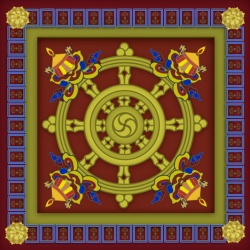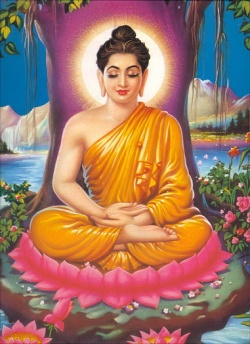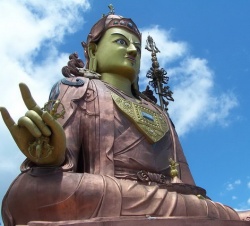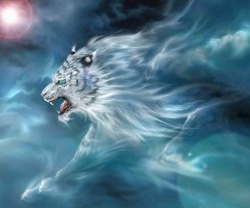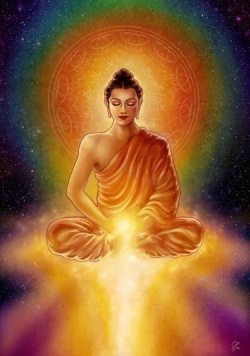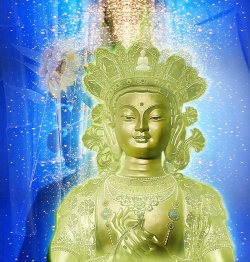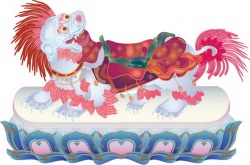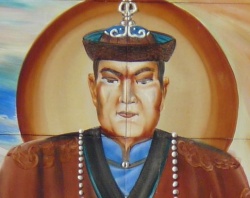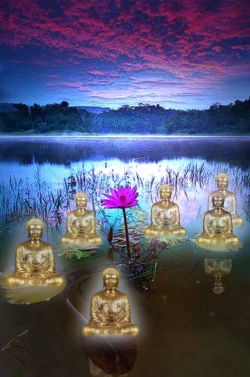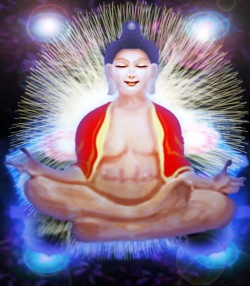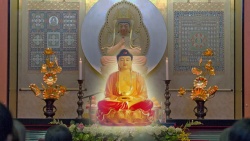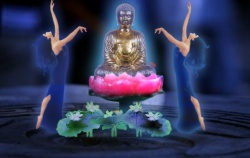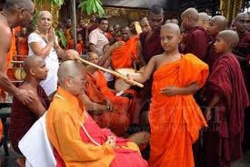Tāranātha (1575-1634)
Tāranātha (1575-1634) is an example of a zhentong proponent who used the term zhentong in a way that encompasses both the sense of philosophical tenet system (drupta) and of practice tradition (gomluk).34
He is said to have had visions of Dölpopa during the composition of several of his texts.
His writings served in turn as a significant inspiration for Jamgön Kongtrül Lodrö Tayé’s writings on zhentong35 and other subjects.
Jamgön Kongtrül Lodrö Tayé is an example of a later zhentong proponent who presents zhentong as a separate philosophical tenet system.36
We will now use Tāranātha’s text, The Twenty-One Profound Points (zapdön nyerchikpa),37 as a lens into the positions of the first two masters cited in Pema Bidza’s list, Dölpopa Sherap Gyeltsen and Shakya Chokden.
Their positions are compared in detail by Tāranātha with respect to twenty-one issues.
The fact that Tāranātha introduces the discussion using the term zhentong umé tagom (theory and practice of the Empty of Other Central System) indicates that his text seeks to encompass the discourse of two fields of inquiry: philosophical point of view theory (tawa) and meditation (gom).
He says:
I think that it is impossible for any contradiction to exist in the intention behind the explanation of those who see the profound [[[reality]]].
However, seeing what is needed for training various people, differences were [explained] conventionally.
Here, the Lord of Dharma, the great omniscient Tönpa Zhiden Dölpopa, and the great pendita, the victorious Shakya Chokden, agree on the essential point of the view and meditation of Zhentong Madhyamaka. However, when ascertaining their view provisionally there are many minor differences between their philosophical tenet systems.38
Tāranātha presents Shakya Chokden’s position first, referring to him as “former” (ngama), and Dölpopa’s position last, referring to him as “latter” (chima).39 They are introduced in this order in the text as a way of expressing a hierarchical order of profundity according to the author.
My impression is that Tāranātha wishes to restate Dölpopa’s original zhentong by showing how it differs from Shakya Chokden’s version of zhentong.
But does Tāranātha’s admiration for and identification with Dölpopa allow for an accurate portrayal of Dölpopa’s position? Tāranātha seems in many cases to be speaking on Dölpopa’s behalf, and so we can to a certain extent read what is portrayed as Dölpopa’s position as being actually Tāranātha’s own position.
Another issue is whether Tāranātha uses a given point in time as definitive for portraying Shakya Chokden’s position in regard to the twenty-one points,40 since Shakya Chokden’s position vis-à-vis the rangtong/zhentong problematic is known to have changed during his lifetime.
He has been described by Tuken Lozang Chökyi Nyima (1737-1802) as starting out as a (rangtong) mādhyamika, then becoming a Cittamātra (ṃind Only ṣystem) proponent, and then ending up as a jonangpa (zhentong mādhyamika).
According to Dreyfus,41 the second period, which started when Shakya Chokden was around the age of forty-nine, is more accurately described as Central Yogic Conduct System (yogācāra-madhyamaka), and in particular as False Aspectarian Yogic Conduct System, which surpasses the Mind Only System.42
During the last phase, starting when he was around fifty-six, he claimed the jonangpa position to be “a more appropriate way to account for the experiential side of the realization of emptiness.”43
Among the points covered in Tāranātha’s text are the issues of whether the second turning is of literal or non-literal meaning and whether zhentong might also be taught in the second turning and not exclusively in the third turning of the wheel of dharma.
Tāranātha remarks in this connection that there is a difference between the rangtong intention of The Victorious One and his sons, and that which is known as rangtong “these days”:44
The former [viz., Shakya Chokden] says, “On the level of philosophy (tawa), rangtong is profound for cutting through elaborations. On the level of meditation (gompa), zhentong is profound for bringing experience (nyamsu lenpa).”45
Here rangtong is identified as the tradition of Prāsaṅgika, of the Svātantrika, as well as that of the model treatises.46
The latter [viz., Dölpopa] says that the rangtong philosophy explained by the Victorious One and his sons is excellent for cutting through elaborations, but the philosophical tenet (tadrup)47 comprising zhentong is not different in this respect.
That which is known as rangtong these days takes the view of Prāsaṅgika, Svātantrika, as well as the model treatises to mean that the ultimate is unreal.
That is a mistake. It is not a wholesome way of cutting elaborations through philosophy since it is a denigration.48
Shakya Chokden’s position is depicted as sympathetic to zhentong while remaining within the generally accepted framework of logical discourse when it comes to theory. He acknowledges the role that zhentong plays on the level of meditation.
He is shown to hold rangtong as the highest view since he argues that because non-dual pristine awareness (nyimé yeshé) cannot withstand logical scrutiny it cannot have an ultimate place in the context of logical discourse.
Dölpopa argues that non-dual pristine awareness can withstand logical scrutiny since it is beyond the reach of the logical mind.49 In this context the two masters are obviously speaking from two different perspectives. While Shakya Chokden is speaking of view, Dölpopa is speaking of that which transcends view.
The two masters are shown to differ on the value they give to trisvabhāva (three-fold nature) vis-à-vis the two truths, on their positions concerning rangrik, on the status of tathāgatagarbha, and on their understanding of mantra[-yāna], but in particular they are shown to differ on whether the nature of non-dual pristine awareness is permanent or impermanent, whether it is an entity or a non-entity, and whether it is compounded or uncompounded.
Here Dölpopa’s arguments transcend (or disregard) the logical categories by stating that while non-dual pristine awareness is permanent in the sense that it is beyond the three times and is uncompounded in the sense that it is beyond compounded and uncompounded, it is neither an entity nor a non-entity.
Dölpopa believes – according to Tāranātha – that epistemology is insufficient when it comes to establishing the ultimate. He does accept the logic of non-dual pristine awareness as a cognition, but refutes its inclusion in the logical category of entities (ngöpo), where cognition normally belongs, at least according to a good deal of Buddhist epistemological literature.
He says, “To assert a non-entity as existing ultimately is not a logical teaching, but to assert an entity as being ultimate is the tradition of proponents of substantialism.”50 Whether this last remark in fact is Tāranātha’s way of defending Dölpopa against his later critics can only be asserted by studying Dölpopa’s own writings in detail.
However, this exchange serves to illustrate the complexities involved when an already ahistorical and fictive discussion covers more than one level of discourse.
[34] Tāranātha was a prolific writer on many subjects.
In a short text called The Central Causal and Resultant Drop (gyundré umé tiklé), Tāranātha describes tathāgatagarbha in its sūtra and tantra context; see Tāranātha, The Collected Works of Jo-naṅ Rje-btsun Tāranātha, vol. 13 (Leh, Ladakh: C. Namgyal & Tsewang Taru, 1982-87), 463-68.
In The Heart of Zhentong (zhentong nyingpo; Tāranātha, Collected Works of Jo-naṅ Rje-btsun Tāranātha, vol. 4, 491-514), he outlines the position of zhentong in relation to various topics. For a study of this work see Klaus-Dieter Mathes, “Tāranātha’s Presentation of Trisvabhāva in the gŹan stoṅ sñiṅ po,” Journal of the International Association of Buddhist Studies23, no. 2 (2000): 195-223.
Finally, The Ornament of Gzhan stong Madhyamaka (zhentong uma gyen; Tāranātha, Collected Works of Jo-naṅ Rje-btsun Tāranātha, vol. 4, 797-824) is, according to Cyrus Stearns in The Buddha from Dol po:
A Study of the Life and Thought of the Tibetan Master Dolpopa Sherab Gyaltsen (Albany: SUNY, 1999), 69, one of Tāranātha’s most important works, devoted solely to the explication of the zhentong view. Lastly, we should mention materials that have only recently come to light, namely texts in the Dzamtang edition of Tāranātha’s Collected Works:
Tāranātha, Collected Works, ’Dzam thang Edition, TBRCW22276. Here we find his extremely interesting interpretations of The Heart Sūtra from a zhentong point of view; see Matthew Kapstein, Reason’s Traces (Boston: Wisdom Publications, 2001), 304-6.
The texts are the Sherapkyi Paröltu Chinpé Nyingpö Dön Nampar Shepa Ngönmé Lekshé (Tāranātha, Collected Works, ’Dzam thang Edition, vol. 17, 571-759) and the Shernyinggi Tsikdrel (Tāranātha, Collected Works, ’Dzam thang Edition, vol. 17, 759-83).
Here Tāranātha identifies three different passages (762, 765, and 771) that he maintains clearly show that The Heart Sūtra teaches zhentong.
While zhentong presentations of tathāgatagarbha are quite common, it is rare to see zhentong elucidations of the second turning of the wheel. Although, for Yogic Conduct System (yogācāra) precursors to these, see Donald S. Lopez, Jr., The Heart Sūtra Explained: Indian and Tibetan Commentaries (Albany: SUNY, 1988), 60, where the statement “form is emptiness, emptiness is form, emptiness is not other than form; form is not other than emptiness” is interpreted as an affirming negative.
[35] Such as Jamgön Kongtrül Lodrö Tayé, Gzhan stong dbu ma chen po’i lta khrid rdo rje zla ba dri ma med pa’i ’od zer, in Rgya chen bka’ mdzod (Paro: Ngodrug, 1975/6), vol. nya (8), 581-621; Nges don dbu ma chen po la ’khrul rtog nyer gsum gyi ’bur ’joms pa legs bshad gser gyi tho ba, in Rgya chen bka’ mdzod, vol. ta (9), 211-18; Lta ba gtan la bebs pa las phro ba’i gtam skabs lnga pa lung dang rig pa’i me tog rab tu dgod pa, in Rgya chen bka’ mdzod, vol. ta (9), 29-68; and Ris med chos kyi ’byung gnas mdo tsam smos pa blo gsal mgrin pa’i mdzes rgyan, in Rgya chen bka’ mdzod, vol. ta (9), 69-100.
[36] See his Shes bya kun la khyab pa’i gzhung lugs nyung ngu’i tshig gis rnam par ’grol ba legs bshad yongs ’du shes bya mtha’ yas pa’i rgya mtsho (Beijing: Mi rigs dpe skrun khang, 1985), 35.1-41.1: glegs bam gsum pa/ skabs bdun pa/ lhag pa shes rab kyi bslab pa rim par gye ba/ ’khor lo gsum gyi drang nges dang bden gnyis rten ’brel rnam par nges pa’i skabs/ lnga pa/ grub mtha’ so so’i ’dod tshul.
Translated into English by Anne Burchardi and Ari Goldfield, Gaining Certainty about the Provisional and Definitive Meanings in the Three Turnings of the Wheel of Dharma, the Two Truths, and Dependent Arising:
The Root Text and Commentary Section Two of Chapter Seven from The Treasury of Knowledge by Jamgön Kongtrül Lodrö Thaye (Kathmandu: Marpa Institute, 1997).
Here he presents the Vaibhāṣika, the Sautrāntika, the Cittamātra, the Svātantrika Madhyamaka, the Prāsaṅgika Madhyamaka, and the Zhentong Madhyamaka view of the two truths as an ascending scale.
The presentation of zhentong as a form of Madhyamaka contrasts with, for example, Mikyö Dorjé’s position that zhentong is more correctly a form of Yogācāra. See Brunnhölzl, Center of the Sunlit Sky, 445.
[37] Tāranātha, Collected Works of Jo-naṅ Rje-btsun Tāranātha, vol. 4, 781-95. For an excellent study and translation of this text see Klaus-Dieter Mathes, “Tāranātha’s ‘Twenty-one Differences with Regard to the Profound Meaning’ – Comparing the Views of the Two gŹan stoṅ Masters Dol po pa and Shakya mchog ldan,” Journal of the International Association of Buddhist Studies27, no. 2 (2004): 285-328.
[38] om swa sti/ zab mo gzigs pa rnams la ni/ bzhed dgongs ’gal ba mi srid snyam/ on kyang gdul bya tha dad dang / dgos pa’i dbang gzigs tha dad bsnyad/ ’dir chos rje kun mkhyen chen po brton pa bzhi ldan dang / paṇḍi ta chen po rgyal ba shākya mchog ldan gnyis/ gzhan stong dbu ma’i lta sgom gyi gnad gcig kyang / gnas skabs lta ba de gtan la ’bebs pa’i skabs/ grub mtha’ mi ’dra ba than thun mang dag yod pa rnams ’dir ngos bzungs bar bya ste (Tāranātha, Zab don nyer cig pa, 782.1-782.3).
[39] Even though Shakya Chokden was born sixty-seven years after Dölpopa’s death.
[40] See Mathes, “Tāranātha’s ‘Twenty-one Differences,’” 315 for an analysis of this.
[41] Georges B. Dreyfus, Recognizing Reality: Dharmakirti’s Philosophy and Its Tibetan Interpretations (Delhi: Sri Satguru Publications, 1997), 28-29.
[42] See also Iaroslav Komarovski, Three Texts on Madhyamaka by Shakya Chokden (Dharamsala: Library of Tibetan Works & Archives, 2000), 59 n. 27.
[43] Dreyfus, Recognizing Reality, 29. Shakya Chokden’s brilliant expositions relevant to zhentong research include, among others: Byams chos lnga’i nges don rab tu gsal ba zhes bya ba’i bstan bcos, in Collected Works, vol. 11 (Thimphu: Kunzang Tobgye, 1975), 1-38; Byams chos lnga’i lam gyi rim pa gsal bar byed pa’i bstan bcos rin chen sgron gyi sgo ’byed, in Collected Works, vol. 11, 39-156; and Rgyud bla’i rnam bzhad sngon med nyi ma, in Collected Works, vol. 13, 113-58. For a translation of the latter see Anne Burchardi, Shakya mchog ldan’s Literary Heritage in Bhutan (The National Library of Bhutan, forthcoming).
[44] deng sang rang stong gi lta bar grags pa (Tāranātha, Zab don nyer cig pa, 783.5). I assume that deng sang refers to Tāranātha’s time and not to Dölpopa’s. Tāranātha has the following comment on what he considers the original meaning of rangtong in his Gyundré Umé Tiklé. He says: “When it was taught that the ultimate is empty of own essence, the intention was that, when observing the ultimate, there is nothing for the intellectual mind to hold on to” (don dam rang gi ngo bo stong pa ltar/ gsung pa’i dgongs pa don dam la dmigs nas/ blo yis bzung ltar ma grub pa la dgongs; Tāranātha, Rgyu ’bras dbu ma’i thig le, in Collected Works of Jo-naṅ Rje-btsun Tāranātha, vol. 13, 466.7-467.1).
[45] Nyamsu len is often translated as “practice,” meaning “bringing into experience.”
[46] The Madhyamaka treatises of Nāgārjuna and Āryadeva.
[47] Combined abbreviation of tawa and drupta.
[48] yang snga mas/ lta bas spros pa gcod pa la rang stong zab/ sgom pas nyams su len pa la gzhan stong zab ces te/ de’i rang stong yang thal rang gzhung phyi gsum gyi lugs la ngos ’dzi[n]/ phyi mas ni/ rgyal ba sras bcas bzhed pa’i rang stong gi lta ba de spros pa gcod byed mchog yin yang / gzhan stong du ’dus pas lta grub logs logs pa min la/ deng sang grags pa’i rang stong thal rang gzhung phyi gsum gyi lta ba don dam bden med du ’dod pa ni nor pa yin pas/ lta bas spros pa gcod pa la bzang ba min te/ skur ’debs su ’gyur ba’i phyir yin zhes gsung / (Tāranātha, Zab don nyer cig pa, 784.4-784.7).
[49] Literally: “Since non-dual wisdom withstands logical analysis, when analyzing it, it is said that it is one’s own confusion [that one ends up analyzing]” (gnyis med ye shes rigs pas dpyad bzod yin pas/ de la dpyod pa de rang gi ’khrul gsung; Tāranātha, Zab don nyer cig pa, 785.4).
[50] dngos med don dam du ’dod pa chos mi rigs la/ don dam dngos por ’dod pa dngos smra ba’i lugs so (Tāranātha, Zab don nyer cig pa, 788.1-788.2).

